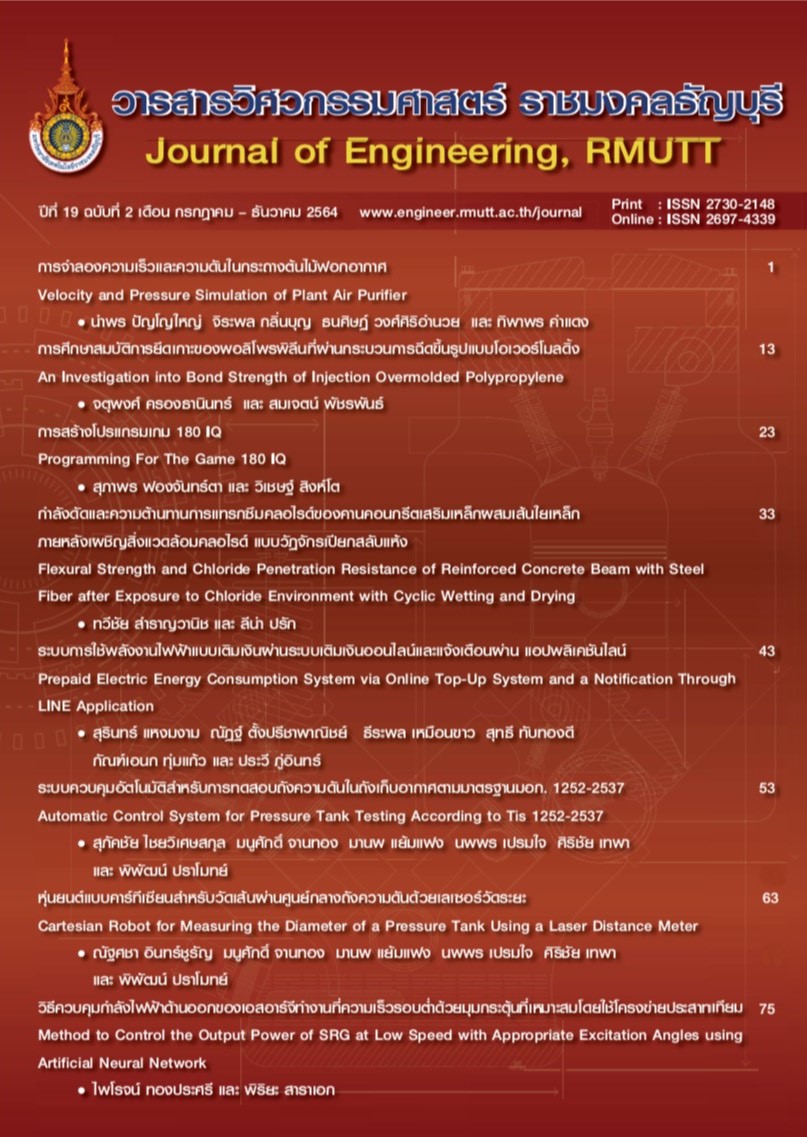วิธีควบคุมกำลังไฟฟ้าด้านออกของเอสอาร์จีทำงานที่ความเร็วรอบต่ำด้วยมุมกระตุ้นที่เหมาะสมโดยใช้โครงข่ายประสาทเทียม
Main Article Content
บทคัดย่อ
พารามิเตอร์สำหรับควบคุมเครื่องจักรกลไฟฟ้าสวิตซ์รีลัคแตนซ์ทำงานโหมดเครื่องกำเนิดไฟฟ้า (เอสอาร์จี) ประกอบด้วย แรงดันดีซีบัส ความเร็วรอบโรเตอร์ และมุมกระตุ้น เมื่อควบคุมแรงดันดีซีบัสและความเร็วรอบโรเตอร์ คงที่ กำลังไฟฟ้าด้านออกของเอสอาร์จีจะขึ้นอยู่กับมุมกระตุ้น บทความนี้นำเสนอวิธีการกำหนดมุมกระตุ้นที่เหมาะสมของเอสอาร์จีโดยใช้โครงข่ายประสาทเทียมเพื่อกำเนิดกำลังไฟฟ้าตามที่กำหนด เมื่อเอสอาร์จีทำงานที่ความเร็วรอบต่ำ โครงข่ายประสาทเทียมที่ใช้เป็นชนิดการเรียนรู้แบบแพร่ย้อนกลับร่วมกับวิธีการฝึกสอน เลเวนเบิรก์-มาร์ควอร์ท อินพุตที่ใช้ในโครงข่ายประสาทเทียมมี 2 ตัวแปร ได้แก่ ความเร็วรอบโรเตอร์และกำลังไฟฟ้า เอาต์พุตที่ต้องการคือมุมกระตุ้น ชุดข้อมูลสำหรับสอนโครงข่ายประสาทเทียมได้มาจากการทดลอง เพื่อเก็บผลกำลังไฟฟ้าด้านออกและมุมกระตุ้นที่ความเร็วรอบคงที่ระหว่าง 1,000-2,000 รอบต่อนาที เอสอาร์จีที่ใช้ในการทดลองเป็นแบบ 4 เฟส 8 ขั้วสเตเตอร์ 6 ขั้วโรเตอร์ พิกัด 48 โวลต์ 2.2 กิโลวัตต์ 6,000 รอบต่อนาที วงจรคอนเวอร์เตอร์ชนิดฮาล์ฟบริดจ์ใช้ขับเอสอาร์จี ประมวลผลด้วย dSPACE DS1202 โปรแกรมควบคุมถูกออกแบบผ่าน MATLAB/Simulink ร่วมกับโปรแกรม ControlDesk เพื่อควบคุมและแสดงผลผ่านหน้าจอคอมพิวเตอร์ ความเร็วรอบโรเตอร์และกำลังไฟฟ้าที่ต้องการถูกกำหนดค่าลงไปในโครงข่ายประสาทเทียมเพื่อให้ทำนายมุมกระตุ้น ผลจาการทดลองกำลังไฟฟ้าที่เอสอาร์จีกำเนิดได้จะมีค่าความคลาดเคลื่อนเฉลี่ย 1.76% เมื่อเทียบกับกำลังไฟฟ้าที่ต้องการ ผลการทดลองนี้ยืนยันความถูกต้องของมุมกระตุ้นที่ได้จากการประมวลผลด้วยโครงข่ายประสาทเทียม
Article Details
บทความ ข้อมูล เนื้อหา รูปภาพ ฯลฯ ที่ได้รับการตีพิมพ์ในวารสารแนวหน้าวิจัยนวัตกรรมทางวิศวกรรม ถือเป็นลิขสิทธิ์ของวารสารฯ เท่านั้น ไม่อนุญาติให้บุคคลหรือหน่วยงานใดคัดลอกเนื้อหาทั้งหมดหรือส่วนหนึ่งส่วนใดไปเผยแพร่เพื่อกระทำการใด ๆ ที่ไม่ถูกต้องตามหลักจริยธรรม
เอกสารอ้างอิง
Li G.J. Zhang K, Zhu Z.Q, Jewell G.W. Comparative studies of torque performance improvement for different doubly salient synchronous reluctance machines by current harmonic Injection. IEEE Transactions on Energy Conversion. June 2019;34(2):1094-104.
Cardenas R, Pena R, Perez M, Clare J, Asher G, Wheeler P. Power smoothing using a flywheel driven by a switched reluctance machine. IEEE Transactions on Industrial Electronics. June 2006;53(4):1086-93.
Ferreira C.A, Jones S.R, Heglund W.S, Jones W.D. Detailed design of a 30-kW switched reluctance starter/generator system for a gas turbine engine application. IEEE Transactions on Industry Applications. June 1995;31(3):553-61.
Schofield N, Long S. Generator operation of a switched reluctance starter/ generator at extended speeds. IEEE Transactions on Vehicular Technology. Jan 2009;58(1): 49-56.
Chen H, Sun C, Wang Q. Analysis of flux-linkage characteristics of switched reluctance linear generator. IEEE Transactions on Applied Supercon-ductivity. June 2014;24(3):5000105- 5000105.
Choi D.A, Byun S.I, Cho Y.H. A study on the maximum power control method of switched reluctance generator for wind Turbine. IEEE Transactions on Magnetics. Jan 2014;50(1):4003004-4003004.
Sikder C, Husain I, Sozer Y. Switched reluctance generator control for optimal power generation with current regulation. IEEE Transactions on Industry Applications. Jan 2014;50(1):590-3.
Yu S, Zhang F, Lee D.H, Ahn J.W. High efficiency operation of a switched reluctance generator over a wide speed range. Journal of Power Electronics. Jan 2015;15(1):123-30.
Zan X, Huo Y, Gu J. Optimization research of turn-on angle and turn-off angle based on switched reluctance starter/generator system. IEEE 28th Canadian Conference on Electrical and Computer Engineering (CCECE). 2015:864-9.
Faiz J, Fazai R. Optimal excitation angles of a high speed switched reluctance generator by efficiency maximization. 12th International Power Electronics and Motion Control Conference. 2006:287-91.
Viajante G.P, Chaves E.N, Miranda L.C, Freitas M.A.A.d, Queiroz C.A.d, Santos Josemar A.d, Gomes L.C, Fidelis R.T. Design and implementation of a fuzzy control system applied to a 6 × 4 SRG. IEEE Transactions on Industry Applications. Jan 2021;57(1):528-36.
Asadi P, Ehsani M, Fahimi B. Design and control characterization of switched reluctance generator for maximum output power. Twenty-First Annual IEEE Applied Power Electronics Conference and Exposition. 2006;1639-44.
Xiong L, Xu B, Gao H, Xu L. A novel algorithm of switched reluctance generator for maximum power point tracking in wind turbine application. International Conference on Sustainable Power Generation and Supply. 2009:1-5.
Sozer Y, Torrey D.A. Closed loop control of excitation parameters for high speed switched-reluctance genera-tors. IEEE Transactions on Power Electronics. March 2004;19(2):355-62.
Babitha S, Kulkarni V, Koujalagi J.P. Vector control based speed and flux estimation in switched reluctance motor using ANN controller. 4th International Conference on Recent Trends on Electronics, Information, Communication & Technology. 2019:10-4.
Rahmanian E, Akbari H, Sheisi G.H. Maximum Power Point Tracking in Grid Connected Wind Plant by Using Intelligent Controller and Switched Reluctance Generator. IEEE Transac-tions on Sustainable Energy. Jul 2017;8(3):1313-20.
Miller T.J.E. Electronic Control of switched reluctance machines. Newnes Publisher. 2001.


